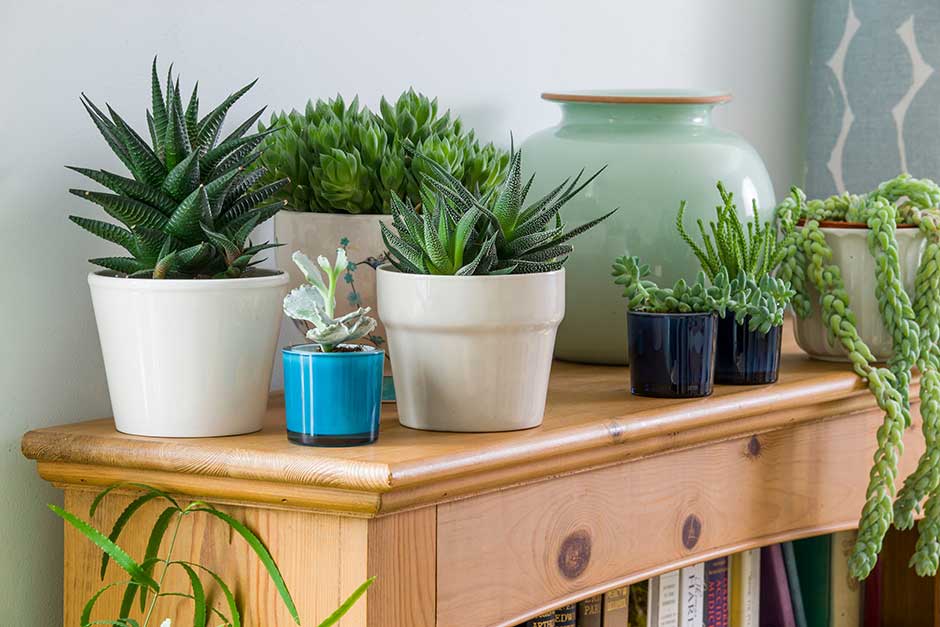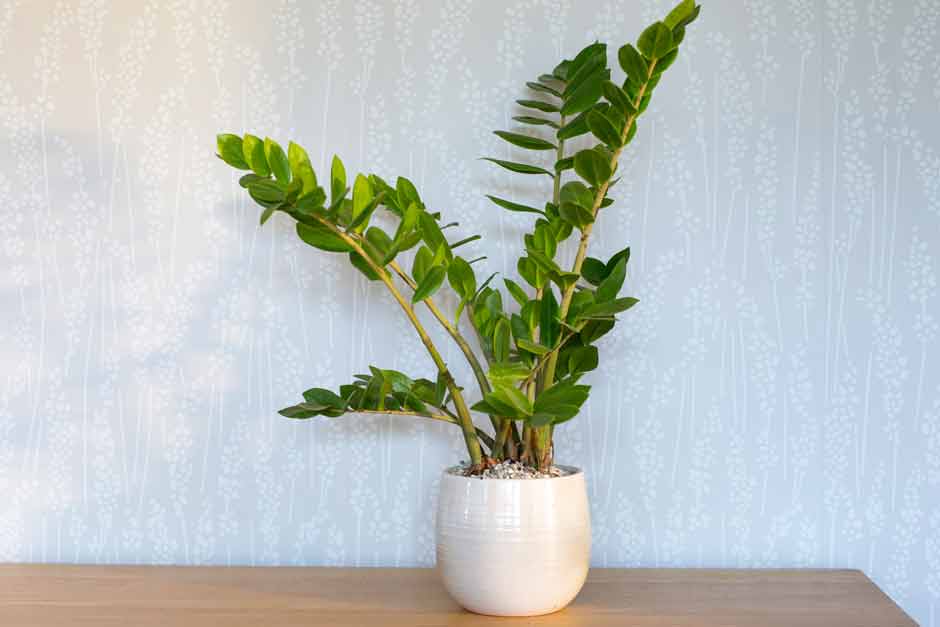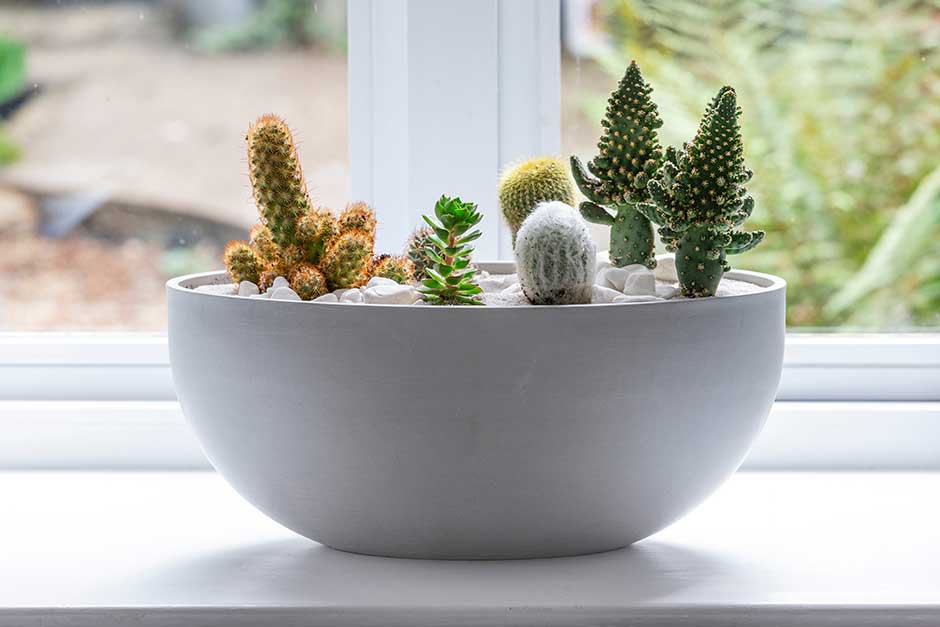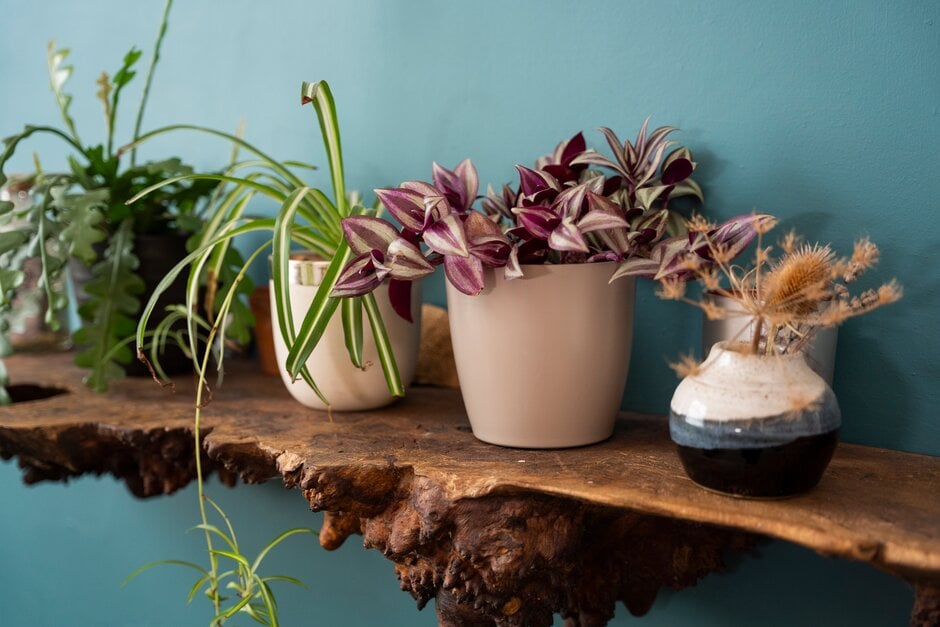Houseplants for different locations
Houseplants bring colour, character, style and a valuable touch of nature into our homes. Here we explain how to select brilliant houseplants that will enhance your living space and thrive in your chosen locations.

Quick facts
Best easy-care succulent: Crassula ovata (jade plant or money tree)
Best year-round flowers: Streptocarpus hybrids (Cape primrose)
Best hanging plant: Ceropegia linearis subsp. woodii (string of hearts)
Best winter colour: Schlumbergera hybrids (Christmas cactus)
Best gift to give a friend: Spathiphyllum wallisii (peace lily)
How to choose houseplants
Healthy, thriving houseplants are not only a joy to look at, they can also help to boost our mental well-being and improve our indoor air quality. Whether you want a bold structural statement, a lush jungle vibe or a delicate floral display, there are lots of beautiful houseplants to suit. But with such a wide range of options readily available, it can be hard to know where to start.
Our warm homes gives us the perfect chance to grow an exciting array of exotic plants that wouldn’t survive outdoors. But conditions vary in different parts of our home. Not all our rooms offer consistent temperatures, and light levels will differ, depending on the size and direction of the windows. The air tends be more humid in bathrooms, but drier in living rooms, especially in winter when the central heating is on.
So the main priority is to select houseplants to suit your location, to ensure they will thrive and look their best without too many problems or excessive maintenance.
For more quick tips, see our video guide:
Also see our list of the best easy-care houseplants.
Providing the right conditions
Indoor growing conditions can vary just as much as outdoors in a garden – the three key aspects to bear in mind are light, humidity and temperature.
Amount of light
Light levels are very important to plants, as is the type of light. Bear in mind that light will fluctuate across the day, and at different times of year. A spot with direct sun in summer will often cause leaf discoloration and scorching, unless the light is filtered by sheer curtains or blinds. But in winter, that location may be a prime growing spot, when the sun is weaker and the days are shorter.
Many plants would struggle in locations set back from windows, where they get very little light. North-facing windowsills can be tricky too, especially in winter when day lengths are reduced.
Domestic lighting doesn’t provide suitable light for plant growth, although artificial grow lamps are widely available if you need to provide additional brightness. But these can be expensive, both to buy and run, and aren’t ideal lighting for most homes.
Humidity levels
Air humidity varies in different rooms. A bathroom or kitchen will often have high humidity, whereas a living room, espeically with the central heating on, will tend to have low humidity.
Many popular tropical plants, such as orchids, need humid air, to mimic their natural growing conditions, so will suffer in a drier atmosphere – their foliage may turn brown and they may fail to thrive. Few houseplants, apart from cacti and succulents, like very dry situations.
Fortunately there are various easy ways to raise the air humidity around your plants – see our video guide for tips:
Temperature
Room temperature can vary from season to season, and between day and night. Locations that become very hot from direct summer sun or from a nearby radiator can lead to leaf damage. Plants left in sun rooms or conservatories over winter can suffer if night temperatures are too cold. Draughts can be damaging too, and hallways tend to be a particular problem area.
So it’s a good idea to check the temperature over 24 hours in different rooms, so you know how much it fluctuates. And consider moving your plants around during the year to make the most of available light and warmth.
For more on growing houseplants successfully, see our guides:

Houseplants for cleaner air

How to grow houseplant cacti and succulents

How to grow houseplants
Recommended houseplants by location
Best houseplants for high light levels
The following houseplants are suitable for locations such as a south-facing windowsill or a sunny conservatory, where both light levels and temperatures can get high. Also see our top 5 plants for sunny rooms.
Small houseplants
Agave filifera AGM (thread agave)
Chlorophytum comosum ‘Variegatum’ AGM (spider plant), C. comosum ‘Vittatum’ AGM (spider ivy ‘Vittatum’)
Echeveria agavoides AGM (moulded wax), E. derebergii AGM (painted lady), E. harmsii AGM (red echeveria), E. secunda var. glauca (glaucous echeveria)
Kalanchoe blossfeldiana (flaming Katy), K. tomentosa AGM (panda plant), K. delagoensis (mother of millions)
Nertera depressa (bead plant)
Pelargonium
Plectranthus oertendahlii AGM
Sedum sieboldii ‘Mediovariegatum’ AGM
Sempervivum tectorum (common houseleek)
Solenostemon (coleus)
Tradescantia fluminensis ‘Quicksliver’ AGM, T. pallida ‘Purpurea’ AGM, T. zebrina AGM
Medium to large houseplants
Agave americana AGM, Agave victoriae-reginae AGM
Beaucarnea recurvata AGM (elephant’s foot)
Bougainvillea
Citrus
Clivia miniata AGM
Codiaeum variegatum var. pictum (croton)
Crassula ovata AGM (jade plant)
Dracaena fragrans (Deremensis Group) ‘Lemon Lime’(v) AGM (dragon tree), D. marginata ‘Tricolour’
Ensete ventricosum AGM (Abyssinian banana)
× Fatshedera lizei ‘Annemieke’ AGM (tree ivy)
Ficus benjamina AGM (Benjamin fig tree)
Gardenia jasminoides AGM (Cape jasmine)
Gynura aurantiaca ‘Purple Passion’ AGM (velvet plant ‘Purple Passion’)
Hedera (ivy)
Hibiscus rosa-sinensis (tropical hibiscus)
Hoya lanceolata subsp. bella AGM (wax plant), H. carnosa ‘Variegata’ AGM
Jasminum polyanthum AGM (many-flowered jasmine)
Justicia brandegeeana AGM (shrimp plant)
Kalanchoe beharensis AGM, K. daigremontiana (Mexican hat plant)
Lantana camara
Musa acuminata (Aaa Group) ‘Dwarf Cavendish’ AGM (banana)
Nerium oleander (oleander)
Persea americana (avocado)
Phoenix canariensis AGM (canary island date palm)
Plectranthus thyrsoideus
Sansevieria trifasciata (snake plant)
Yucca aloifolia, Y. elephantipes
Best houseplants for lower light levels
These houseplants are suitable for locations such as north- or north-east-facing windowsills and shaded conservatories. They need a minimum night-time temperature of 10°C (50°F) and should be allowed to partially dry out between watering, especially in winter. Also see our guide to houseplants for shady rooms.
Small houseplants
Chlorophytum comosum ‘Variegatum’ AGM (spider plant), C. comosum ‘Vittatum’ (v) AGM
Cyperus albostriatus, C. involucratus AGM (umbrella plant) keep it standing in 1cm of water at all times
Hedera helix ‘Duckfoot’ AGM (ivy)
Maranta leuconeura var kerchoveana AGM (prayer plant), M. leuconeura var erythroneura AGM (herringbone plant)
Peperomia obtusifolia AGM)
Plectranthus verticillatus, P. oertendahlii AGM
Selaginella kraussiana AGM (needs humid conditions), S. martensii ‘Variegata’ (needs humid conditions)
Soleirolia soleirolii (mind-your-own-business) note: can become invasive if grown outdoors
Streptocarpus (syn. Saintpaulia) (African violet)
Tradescantia fluminensis
Medium to large hosueplants
Aechmea fasciata AGM (silver vase plant)
Aglaonema ‘Sliver Queen’ AGM, A. crispum
Asparagus densiflorus ‘Meryersii’ AGM, A. setaceus ‘Pyramidalis’ AGM
Aspidistra elatior AGM (aspidistra)
Begonia rex cultivars, B. metallica AGM (metal-leaf begonia), B. masoniana AGM (iron cross begonia)
Bromeliads (e.g. Aechmea, Billbergia, Neoregelia)
Cissus antarctica AGM, C. rhombifolia AGM
Cordyline fruticosa ‘Kiwi’
Dieffenbachia ‘Camille’ AGM (Dumb cane)
Epipremnum aureum AGM
× Fatshedera lizei AGM (tree ivy)
Ficus benjamina AGM (Benjamin fig tree), F. elastica (India rubber tree)
Hedera helix (ivy)
Lapageria rosea AGM (Chilean bellflower)
Monstera deliciosa AGM (Swiss cheese plant)
Peperomia obtusifolia AGM
Philodendron scandens AGM (heart-leaf)
Pilea cadierei AGM
Pteris cretica var. albolineata AGM
Sansevieria trifasciata (snake plant)
Schefflera actinophylla AGM (umbrella plant), S. arboricola ‘Gold Capella’ AGM
Syngonium podophyllum AGM (nephthytis)
Zamioculcas zamiifolia (fern arum)
Best houseplants for low light and fluctuating temperatures
These plants can cope in locations such as a hallway or single-glazed room that could be centrally heated by day but cold and draughty at night.
Chamaedorea elegans AGM (parlour palm)
Chlorophytum comosum ‘Variegatum' (v) AGM (spider plant), C. comosum ‘Vittatum' (v) AGM
Epipremnum aureum AGM (Ceylon creeper)
× Fatshedera lizei AGM (tree ivy)
Ficus elastica (India rubber tree)
Soleirolia soleirolii (mind-your-own-business) note: can become invasive if grown outdoors
Philodendron scandens AGM (heart-leaf)
Sansevieria trifasciata (snake plant)
Senecio macroglossus ‘Variegatus’ AGM
Syngonium podophyllum AGM (nephthytis)
Best houseplants for bathrooms
These plants will thrive in humid locations where the temperature can be cool.
Climbing/trailing houseplants
Cissus antarctica AGM (kangaroo vine), C. rhombifolia AGM (grape ivy)
Epipremnum aureum AGM (Ceylon creeper)
Hedera helix (ivy)
Philodendron scandens AGM (heart-leaf)
Plectranthus verticillatus
Syngonium podophyllum AGM (nephthytis)
Tradescantia fluminensis ‘Quicksliver' (v) AGM, T. zebrina AGM (silver inch plant)
Small houseplants
Acorus gramineus ‘Variegatus' (v) (variegated slender sweet flag)
Adiantum capillus-veneris (maidenhair fern)
Carex morrowii ‘Fisher Form’
Chlorophytum comosum ‘Variegatum' (v) AGM (spider plant), C. comosum ‘Vittatum' (v) AGM
Cyperus albostriatus, C. involucratus AGM – stand it in 1cm of water at all times
Pteris cretica AGM
Saxifraga stolonifera AGM (strawberry saxifrage)
Selaginella kraussiana AGM (krau’s clubmoss), S. martensii AGM (martens club moss), S. uncinata AGM (peacock moss)
Soleirolia soleirolii (mind-your-own-business) note: can become invasive if grown outdoors
Tillandsia cyanea AGM (pink quill)
Medium to large houseplants
Asplenium nidus AGM (bird’s nest fern)
× Fatshedera lizei AGM (tree ivy)
Ficus benjamina AGM (Benjamin fig tree)
Monstera deliciosa AGM (Swiss cheese plant)
Nephrolepis exaltata ‘Elegantissima’ AGM (sword fern)
Schefflera actinophylla AGM (umbrella plant), S. arboricola ‘Gold Capella’ AGM
Best houseplants for cool, bright locations
These plants will be happy where the minimum winter night temperature is above freezing – such as in a sun room, unheated conservatory or enclosed porch.
Cacti and succulents
Aeonium arboreum ‘Atropurpureum’ AGM (dark purple houseleek tree), A. haworthii AGM, A. tabuliforme AGM , A. undulatum
Agave parryi AGM, A. utahensis AGM
Aloe humilis (spider aloe), A. variegata AGM (variegated candelabra aloe), A. vera AGM
Cereus uruguayanus
Opuntia cantabrigiensis, O. compressa, O. fragilis (brittle cactus), O. polycantha
Sempervivum arachnoideum AGM (cobweb houseleek), S. calcareum, S. ciliosum AGM, S. tectorum AGM (common houseleek)
Climbing/trailing hsoueplants
Ampelopsis brevipedunculata ‘Elegans' (v)
Chlorophytum comosum ‘Variegatum' (v) AGM ( spider plant), C. comosum ‘Vittatum' (v) AGM
Cissus antarctica AGM (kangaroo vine)
× Fatshedera lizei AGM (tree ivy)
Hedera helix (ivy)
Jasminum mesnyi AGM (primrose jasmine), J. polyanthum AGM (many-flowered jasmine)
Saxifraga stolonifera AGM (strawberry saxifrage)
Tolmiea menziesii AGM (pickaback plant)
Tradescantia fluminensis ‘Quicksliver’ AGM, T. zebrina AGM (silver inch plant)
Shrubs and perennials
Araucaria heterophylla AGM (Norfolk Island pine)
Aspidistra elatior AGM (aspidistra)
Aucuba japonica (spotted laurel)
Buxus sempervirens (common box)
Campanula isophylla AGM (falling stars)
Euonymus japonicus (evergreen spindle)
Fatsia japonica AGM
Grevillea robusta AGM
Pelargonium
Schefflera actinophylla AGM (umbrella plant)
Soleirolia soleirolii (mind-your-own-business) note: can become invasive if grown outdoors
Trachycarpus fortunei AGM (Chusanl palm)
Ferns
Adiantum hispidulum (maidenhair fern), A. raddianum AGM
Asparagus densiflorus ‘Meryersii’ AGM (foxtail fern), A. densiflorus Sprengeri Group AGM (emerald feather), A. falcatus
Asplenium bulbiferum Forst.f. (hen and chicken fern), A. nidus AGM (bird’s nest fern), A. scolopendrium AGM (hart’s tongue fern)
Cyrtomium falcatum AGM (Japanese holly fern)
Nephrolepis exaltata AGM (sword fern)
Pteris cretica AGM, P. tremula
Best houseplants for unheated locations above freezing
Camellias – culltivars of Camellia japonica and C. × williamsii
Clivia miniata AGM)
Crinum × powellii AGM
Pseudosasa japonica AGM
Pleioblastus viridistriatus AGM
Fargesia nitida
Best houseplants to give as gifts
See also...
Get involved
The Royal Horticultural Society is the UK’s leading gardening charity. We aim to enrich everyone’s life through plants, and make the UK a greener and more beautiful place.